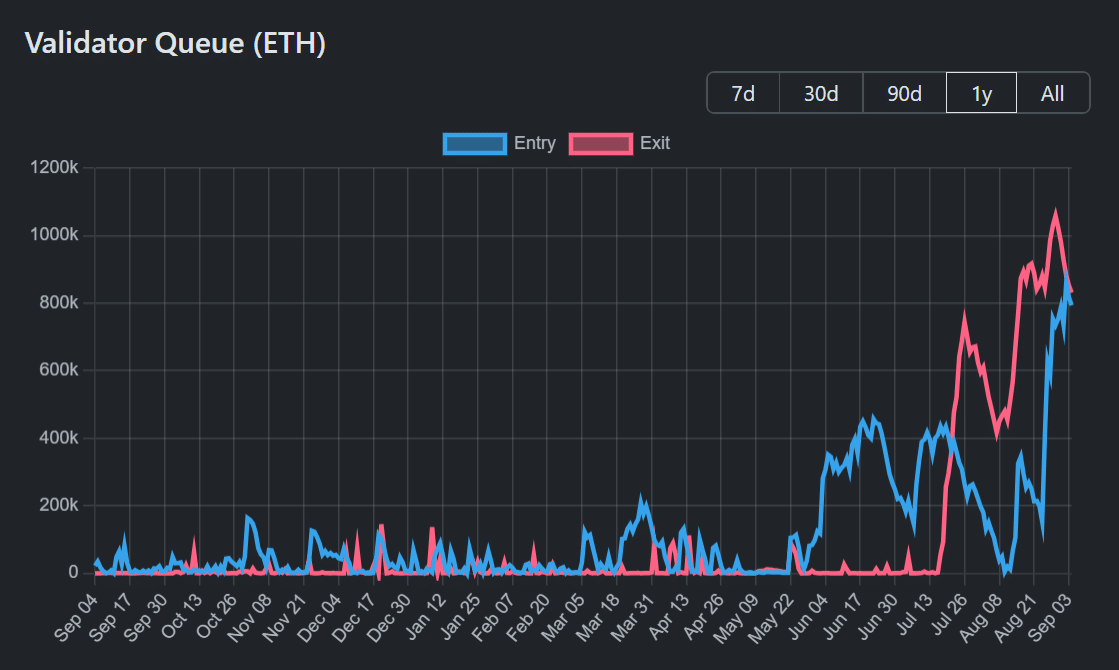Ethereum’s Rising Validator Queue and Restaking Activity Could Signal a Growing Supply Squeeze
Contents
The Ethereum validator queue has surged to a two-year peak of 860k ETH, signaling increased staking demand and a potential supply squeeze. Combined with ~36M ETH already staked and rising restaking activity, this dynamic supports structural bullish pressure on ETH over the medium term.
-
860k ETH queued — a two-year high
-
Total Value Staked (TVS) near 36M ETH, down from a 36.23M peak in early August.
-
Queue represents roughly $3.7B or ~2.9% of supply; combined locked/queued ETH could exceed 38M (32%+ of supply).
Ethereum validator queue climbs to 860k ETH, tightening supply and boosting staking flows. Read analysis on ETH staking impact and next steps for investors.
What is the Ethereum validator queue and why does it matter?
The Ethereum validator queue is the backlog of ETH waiting to become active validators on the Beacon Chain. A large queue means substantial ETH is effectively locked from liquid markets, increasing supply pressure and potentially supporting price if demand persists.
How much ETH is currently queued and staked?
Validator queue data shows the entry queue spiked to 860k ETH on 2 September, roughly $3.7 billion in queued capital. Ethereum’s TVS reached a high of 36.23 million ETH in early August and sits near 36 million today after ~230k ETH unstaked in under a month.


Source: Validatorqueue
How do staking flows and restaking affect ETH supply?
Staking removes ETH from liquid markets; restaking protocols layer additional yield on top of staked ETH. For example, EigenLayer’s TVL has reached record levels, showing capital is increasingly committed to multilevel lock-ups and yielding strategies.
When restaking ramps, the effective locked supply rises beyond native staking figures. That amplifies potential supply shocks if demand holds or increases.

Source: DeFiLlama
When did staking flows correlate with price action?
Recent data shows TVS fell ~145k ETH across two weeks while ETH’s price pulled back about 12% from the $4.9k peak. Short-term unstaking coincided with price weakness, but the larger trend of rising queued ETH suggests renewed medium-term accumulation into staking.
Quick comparison: staked vs queued ETH
| Metric | Value | Percent of Supply |
|---|---|---|
| Total Value Staked (TVS) | ~36.0M ETH | ~29.45% |
| Validator Queue | 860k ETH | ~2.9% |
| Potential locked (staked + queued) | ~38.0M ETH | ~32% |
Frequently Asked Questions
How does the validator queue affect ETH liquidity?
A large validator queue removes ETH from liquid exchanges and wallets while it waits to activate. That reduces available circulating supply and can amplify price moves if demand remains steady or rises.
Can restaking increase supply pressure further?
Yes. Restaking protocols allow staked ETH to be rehypothecated for additional yield, effectively increasing the amount of ETH that is functionally locked and reducing freely tradable supply.
Key Takeaways
- Validator queue at 860k ETH: Represents meaningful queued capital (~$3.7B) that tightens effective supply.
- TVS near 36M ETH: Even after recent unstaking, staking remains elevated and supportive for long-term demand.
- Restaking adds leverage: Protocols like EigenLayer increase functional lock-up, intensifying potential supply shocks.
Conclusion
Ethereum’s staking dynamics — a two-year high validator queue, sustained TVS, and growing restaking activity — point to structural supply compression beneath the surface. Monitor queue trends, restaking TVL, and on-chain flows to assess whether this translates into durable price support. COINOTAG will continue tracking these metrics and publishing updates.
Crypto Vira
Comments
Yorumlar
Other Articles
BitMine Boosts Ethereum Stake to 461K ETH, Eyes Network Share Growth
January 1, 2026 at 08:06 PM UTC
Ethereum On-Chain Strength Hints at Potential L1 Season in 2026
January 1, 2026 at 10:20 AM UTC
Bitwise Files for 11 Altcoin ETFs Including AAVE, UNI Amid SOL, XRP Muted Gains
December 31, 2025 at 08:47 PM UTC
